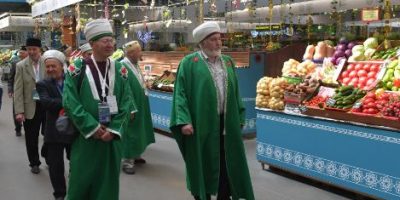Kazakhstan marks 750 years since the formation of the Golden Horde state

NUR SULTAN (DNA) -This year, Kazakhstan marks 750 years since the formation of the Golden Horde state. Initiated in 2019 by Head of state Kassym-Jomart Tokayev, the idea of celebrating the 750th anniversary of the Golden Horde became a logical continuation of the idea of the First President of the Republic of Kazakhstan – Elbassy Nursultan Nazarbayev.
The topic of objective and scientific coverage of the role of Ulug Ulus (Ulus of Juchi, Golden Horde) was repeatedly touched upon in the works of Elbassy, for example, in such fundamental monographs as “Flow of History”, “Kazakhstan’s way”, as well as in the article “Seven Facets of the Great Steppe”. On August 24, 2014, N. Nazarbayev in his interview in Ulytau actually marked the line of the historical succession of Kazakhs from the Golden Horde. On December 22, 2014, the First President of Kazakhstan once again voiced the thesis that the Golden Horde is the historical predecessor of the Kazakh khanate. On September 11, 2015, in Astana, at a solemn meeting dedicated to the 550th anniversary of the formation of the Kazakh khanate, this thesis was restated.
“The Kazakh khanate is the legitimate heir of the states of Saks, Huns, Usun, as well as the Great Turkic Khaganate, Desht-I-Kipchak and the Golden Horde,” Elbassy said.
On February 18, this year, the Press Service of the First President of Kazakhstan – Elbassy published his words about the history of the Kazakh people on his Instagram page: “My contemporaries, subsequent generations in their time counted history only from the period of the October Revolution. For us, there was no other history of the Kazakhs, but now we must study it in depth. Our ancestors are Huns, and the Great Turkic Khaganate is even closer in time. Our land has always been the center of those states. The next is the Golden Horde. If you summarize all this, our history dates back two thousand years. Having passed through such a huge period of time, we managed to preserve our language, religion, and identity. And we should educate our young people in this spirit.”
The history of the formation of the Golden Horde dates back to 1269, when the so-called Talas Kurultai was held on the territory of the current Zhambyl region, where a decision was made to divide the Mongol Empire. As a result, the Ulus of Juchi (Golden Horde) gained full independence. In the valley of the Talas river, somewhere at the borders of modern Kazakhstan and Kyrgyzstan, the rulers of the Juchi, Chagatai and Ugedei uluses – namely, Mengu Timur, Borak and Haidu – recognized each other as sovereign rulers, forming an alliance against the great Khan Kublai in case he did not recognize their independence.
The Golden Horde was a multi-ethnic and multi-confessional Eurasian state that was widely known for its policy of tolerance towards various ethnic groups and religions. While gentiles and heretics were burned at the stake of the Inquisition in Europe, Muslims, Christians, Buddhists, and Jews lived in the Great Steppe. The Golden Horde rulers, raising large cities and ensuring the smooth and safe functioning of trade routes, created conditions for a dialogue between the civilizations of the West and the East, the exchange of goods, knowledge, and ideas, and accelerated global development.
All historians who studied the history of the Middle Ages noted that the Kazakhs perceive themselves as part of the Golden Horde world. According to a number of leading experts, the ethnogenesis of the Kazakh people mainly took place during the Golden Horde period, and at the time of the collapse of the Horde, only the modern name “kazak” was lacking, which appeared later, due to a number of political circumstances. However, even then there was almost a single nomadic people of Desht-I-Kipchak, from which modern Kazakhs, Nogais and Karakalpaks are directly descended – three ethnos that are extremely close to each other. Volga and Crimean Tatars and Bashkirs also rightfully consider themselves the heirs of the Golden Horde.
Chokan Valikhanov once wrote: “According to their traditions, the Kirghiz (pre-revolutionary name of the Kazakhs by the Russian Imperial administration) consider themselves descendants of the Tatars of the Golden Horde.” Of course, Chokan Valikhanov’s term “Tatars” is also used in its pre-revolutionary, expansive meaning.
The last of the existing heirs of the Juchi Ulus was the Kazakh khanate, whose 550th anniversary we celebrated in 2015. And Zhanibek and Kerey, the founders of the Kazakh khanate, as well as all subsequent rulers, up to the last Khan – Kenesary, belonged to the Urusid branch of the Chingisids dynasty. Their ancestor Urus Khan – one of the Golden Horde rulers of the XIV century, which some Kazakh historians identify with the legendary Alasha Khan.
The main layer of Kazakh folklore, largely shared with the folklore of the Kazan and Crimean Tatars, Bashkirs, Nogais and Karakalpaks, also dates back to the Golden Horde era. First of all, we remember the images of emir Edige and Asan Kaigy – adviser of Az Zhanibek, the great Horde ruler, who was called “the good tsar Zhanibek” in Russian chronicles. The first actual Kazakh historian, as you know was Kadyrgali Zhalairi. His book “Zhamigat-tavarikh” is the first Kazakh historical work, this book shows the direct connection between the Kazakh khanate and the Golden Horde, gives an internal view of its history. The influence of the Golden Horde on the spiritual culture of Kazakhstan was clearly reflected – it was from the Horde, from the Berke and Uzbek khans that we inherited our traditional Hanafi madhhab of Sunnism, with its rational approach and tolerance. On the territory of Kazakhstan, there is a huge number of written sources and cultural monuments associated with the Golden Horde. For example, historians are well aware that Kazakhstan is a kind of “champion” in Central Asia in terms of the number of epigraphic monuments (tombstone inscriptions) of the Golden Horde epoch. We should also mention the mausoleum of Zhoshy Khan (Juchi) in Ulytau. In addition, in the Atyrau region there is a settlement of Sarayshyk – one of the capitals of the Golden Horde, where a number of khans of the Golden Horde (Sartak, Berke, Toktakiya, Dzhanibek, according to some information, and Mengu Timur), Kazakh Khan Kasym, Nogai princes Ismail and Uraz were buried. In fact, Sarayshyk was the first stationary capital of the Kazakh khanate at the beginning of the XVI century. The name of the national currency of Kazakhstan – “tenge “comes from the name of the Golden Horde currency “dang”. By the way, the Russian “money” also comes from it.
Unfortunately, during the Stalinist period, in 1944, the Soviet Union officially banned the study of the Golden Horde. At the same time, the Golden Horde historical and heroic epic “Edige”, common to Kazakhs, Nogais, Karakalpaks, Tatars and Bashkirs, was declared reactionary and banned. A number of prominent historians were persecuted during this period. Subsequently, the Horde theme remained under complete ban until the 80’s, when it was in Kazakhstan revived by Veniamin Yudin. Also in the 80’s, Ilyas Esenberlin’s trilogy “Altyn Orda” was published – the only literary work in the history of Soviet Kazakhstan about this glorious page of national history.
The first breakthrough in the study of the Golden Horde period occurred in 2004 thanks to the state program “Mádenı mura”. Within its framework, medieval sources were introduced into the scientific circulation, cultural monuments were restored, and works of domestic and foreign scientists were published. In recent decades, a number of scientists have worked in Kazakhstan in this direction: A. Muminov, M. Abuseitova, Zh. Tulibayeva, A. Kadyrbaev, A. Kushkumbaev, R. Temirgaliev, Zh. Sabitov. These experts have done a lot to research and popularize the heritage of the Golden Horde.
In 2019, the Turkic Academy published a number of scientific works devoted to the history and cultural heritage of the Golden Horde: the 5-volume work of Rashid ad-din “Zhamik-at-tauarikh” translated into Kazakh; “Historical and Comparative Dictionary of the Turkic Languages of the XIV century” by E. Najip, compiled on the basis of the language of the Golden Horde monument of literature “Khusrau and Shirin”; “The Secret Legend of the Mongols”, translated into Kazakh; collection of scientific articles “The Golden Horde: history, statehood, cultural heritage”. In May, the Academy jointly with UNESCO held in Paris the international forum “the Great Steppe: cultural heritage and role in world history”, inspired by the ideas of the program article of the First President of the Republic of Kazakhstan Nursultan Nazarbayev “Seven Facets of the Great Steppe”. A number of sections were devoted to the cultural heritage of the Golden Horde.
The well-known domestic historians and political scientists agree that the appeal to the Golden Horde heritage will contribute to the further integration of Kazakhstan’s ethnic groups into a single civil nation, consolidated around the state-forming Kazakh people, and is a valuable strategic resource for modern Kazakhstan.
Related News

The largest halal fair in Russia will open on 14 MAY
ISLAMABAD, /DNA/ – More than 40 thousand visitors and 4.5 thousand goods according to HalalRead More

Saudi Foreign Minister to visit Pakistan
DNA ISLAMABAD: A high-level Saudi delegation, led by Foreign Minister Prince Faisal bin Farhan binRead More


Comments are Closed